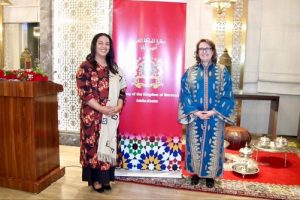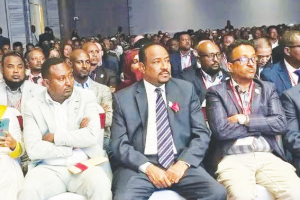BY MULUGETA GUDETA
What else after the successful celebrations of Irreechaa Finfine and Irreechaa Hora Arsedi last week? Maybe it is time to think about the tradition more seriously, more profoundly and more creatively. It may also be time to give it African dimension. According to recent data, Irreechaa was celebrated in this part of Africa for the last 12000 years, since what expert called “Cushitic times”. It may also be the oldest tradition on the continent. Obviously Irreechaa was celebrated differently in different times and it cannot continue to be celebrated in the same way in the future.
There are now talks about modernizing Irreechaa or celebrating it in a modern way or in accordance with changing times so that it can respond to changing human needs and human aspirations. In the old times the main focus of Irreechaa might have been a prayer to the Creator so that nature provided its bounties to humans and the seasons change in accordance with the will of Waqqa. Even in the 20th century, Irreechaa has undergone profound changes. At one time or another it was used as a political tool to rally the Oromo people behind this or that interest. It was manipulated by the educated elites to advance their narrow political agendas.
All these attempts were nipped in the bud because they did not reflect the traditional wishes of the Oromo people who suffered and prayed to live in peace, and natural abundance. They prayed to Waqqa to protect them against all kinds of intruders, invaders and natural as well as human forces that tried to undermine, belittle or change traditional belief systems.
In the past, all traditional belief systems were undermined as “backward” superstitions that hinder modernization and refused to bend to so-called modern ideologies. Public celebrations were discouraged and attempt were made to confine it to the village levels. Yet, traditional beliefs could not be weakened let alone wiped out as the educated elites wished it. In the meantime Irreechaa and other traditional beliefs and rituals were consolidated instead of losing their appeals as the detractors wished. And now as the 21st century down, Irreechaa and similar popular beliefs and rituals emerged intact and continue to win more spiritual grounds and more followers as the new generations continue to uphold the practices of their forefathers without changing it. The wind of politics might blow in all directions but traditional practices remain as they were thousands of years back, without altering the fundamental rituals and by adding new dimensions that reflected the wishes and aspirations of the people. For that matter, all religions survived human attempts to suppress them simply because they are based on immutable and divine principles while the detractors always lose ground or disappear without a trace.
Suffice it to observe this year’s celebrations of Irreechaa in Addis Ababa or Finfinee as the Oromo people call it, and in Bishoftu. More than 70 percent of the celebrants were no doubt young people in their twenties and thirties while elderly people are in the minority maybe because they could not travel long distances to come to the centers of the celebrations.
What was amazing about the young celebrants was the unprecedented enthusiasm, love and happiness they displayed everywhere they went chanting and dancing their traditional dances. This is another confirmation that traditions don’t die with time but assume new and energetic dimensions thanks to the new generations that uphold the rituals of their forefathers in the belief that they too would reap the benefits of divine intervention, divine blessings and natural bounties.
Then what do we mean by modernizing Irreechaa rituals and traditions? Irreechaa is said to be the reflection or the cultural manifestation of the Gadda system that was the rule rather than the exception in the distant past. One of the pillars of the Gadda system is the age-based system of self-government or self-administration of the people by the people and for the people. It is one thing to celebrate Irreechaa with flamboyant sounds and colors and give it a “modern” dimension by playing music on people of powerful sound system. But this is not the only “modernization” trends of the Irreechaa.
What matters about Irreechaa is its day to day rules of living and interacting in accordance with the traditional Gaada system of self-rule based on hierarchies of age and gender. Women too are not excluded from Irreechaa celebrations and they have their gender-based rules and functions. Irreechaa does not confine women to the kitchen but brings them out into public view and allows them to play the role of mediators during prayer rituals to Waqqa. This is undoubtedly in line with any modern thought system, weather with democracy or otherwise that embraces women as important social actors and agents of transformations and up keepers of old traditions.
Many people believe that the economic dimensions of Irreechaa as a tourist attraction have not been fully exploited. That is true but Irreechaa goes beyond touristic or economic concerns. It is bigger, more profound and more significant than earning more hard currencies through tourism expansion although this is also a no mean exercise. This year’s celebrations of Irreechaa was remarkable for the dressing codes and the variety and diversity of the designs and styles of traditional clothing that were the main focus of the media and all those people who attended the events. The colors were bright, symbolizing the bright hopes that the New Year promises.
The variety of modern designs that were brought to the attention of the young celebrants in particular was formidable. In this sense the design and clothing industry should exploit the vast potentials of the Irreechaa dressing code offers to the industry and we may even hope that a special Irreechaa clothing industry would emerge in the future and influence the tastes of millions of youngsters who may abandon Western-style clothing and adopt traditional dressing styles that are cheaper, more meaningful, and most of all, come from their own history, tradition and ancestry.
As we said above, modernizing Irreechaa should not only help change the dress code of the Oromo people but also help them change their mentalities, in the young generation in particular. In addition to dressing code, Irreechaa should also elicit deep thinking into the meaning of self-reliance pride in traditional practices and the need for modernizing them without changing the core beliefs or core practices. It would also be important to look at the Gadda system and Irreechaa critically and purge what is contrary to the core belief of the system or any attempt to politicize it or use it as political tool by some members of the educated elite. Whether in executing the Irreechaa rituals or trying to adopt the positive aspects of the Gadda system, the ultimate authority should remain the Creator who is ruling over nature and taking care of His creations, as the people believe. Any attempt to give Irreechaa a secular or ideological interpretation or practice is bound to fail simply because it would contradict the core belief which is the main pillar of the tradition. Any attempt to codify the belief system or marry it with some other foreign religious interpretations would also be unpalatable and inadvisable because the people know and believe in one Creator and any attempt to dilute or mix it would be not only counterproductive but would also backfire as it did in the past. So, modernizing the Gadda and Irreechaa would boil down to preserving their core beliefs and developing what can be developed through consultation with the people at the village level instead of giving this responsibility to a few elite groups however well-educated they might be.
Educated people have the right and even the duty to do research or write about the Gadda system or Irreechaa in whatever way they wish but their writings should be accessible to the very actors, the Oromo people, who should know and understand any modernizing attempts so that they could express wither their opposition or consent. An elite-driven modernization approach is bound to fail because the elite lack what the people have, namely wisdom, tolerance, insight earned through the accumulated experiences of many generations’ elders. The Gadda system and Irreechaa which is its offshoot cannot be modernized or reformed through the unilateral efforts of colonialism by other means of educated people but with the participation of the elders and traditional leaders.
Western philosophy or Western thought in general undermined African traditional cultures and traditions deliberately sabotaged their potentials for growth or development that could lead to self-reliant system of beliefs and thoughts because of its colonial designs and projects in the past. Neocolonialism is the continuation of colonialism by other means and through the agency of so-called educated elites who bend to foreign diktat and machinations. As such the neocolonial attempts to dilute African traditional thoughts and practices would only be an attempt to help and abet the survival of colonial thinking in the new age and by other means.
In order to thwart such Western ideological plots and machinations, African government should institutionalize their traditional practices, beliefs and rituals by studying them seriously under special government agencies or institutions that would find the right solutions to the modern challenges of not only Irreech or the Gadda system but all the traditions and practices that are serving as weapons of spiritual survival by improving the technological or technical aspects of these practices. Modern technology does not impede old traditions but it is how the technology is used that is important. The advent of the mobile phone that has allowed millions of followers of traditional and cultural practices has allowed them to come together and celebrate these events by relaying messages of goodwill, love, and tolerance.
Western technology becomes anathema when it is used to relay messages of hate, ethnic bigotry, and conflicts. Even then, one cannot avoid technology for serving as a tool of evil communication. What one can do is to change the mentalities of the messengers from malevolence to benevolence, from wickedness to goodness. This is in fact the hardest part of modernizing traditional practices and belief systems in such a way that they serve people better without losing their original messages and founding spirits.
The Ethiopian Herald 9 October 2022





